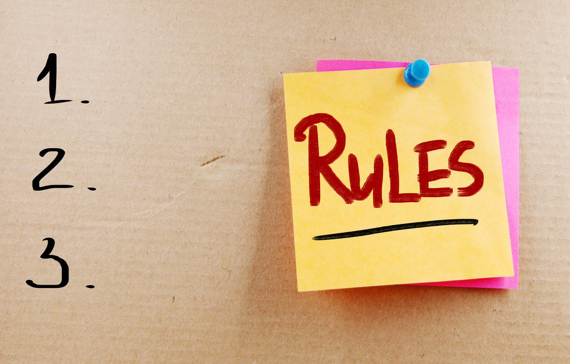What would the world be like without rules and regulations? We'd experience chaos on the roadways, anarchy in our schools, a criminal justice system run amok. In short, we'd stop functioning as a society.
In the workplace, management puts rules in place to keep the organization running efficiently. These rules may concern such issues as work hours, attire, personal computer usage, lunch breaks, employee behavior, and organizational processes and procedures.
Rules help ensure work is completed correctly and diligently while providing guidelines for equitable treatment of employees. But if a company imposes too many rules, employees often feel stifled--and even undervalued. The result? Reduced morale and motivation that, over time, can kill productivity across the organization--the exact opposite effect management hopes to achieve.
Is it time to review your employee rulebook? First, consider the consequences of enacting too many--or the wrong type--of rules in the workplace.
Poor Employee Engagement
Employees feel engaged when you put their opinions, talents, and ideas to real use. Corporate rules that employees consider unnecessary may thwart that feeling of engagement. Employees may feel their employer doesn't trust them to use their best judgment, which can lead to a sense of frustration and powerlessness. They may feel less inclined to do the job, knowing their unique ideas and viewpoints won't be valued. Stifling rules risk driving your best, most creative employees away.
Lack of Efficiency
Want to slow a project down? Add a bunch of rules and paperwork to gum up the process. In a recent Ted Talk, Yves Morieux, director of The Boston Consulting Group's Institute for Organization, warned against an overabundance of rules, processes, and metrics that keep organizations from getting things done. "If you think about it, we pay more attention to knowing who to blame in case we fail, than to creating the conditions to succeed," he told his audience.
In many cases, overemphasis on rules and processes creates added paperwork and leads to time-consuming meetings that add nothing to the organization's ability to get things done. "This is what is killing productivity--what makes people suffer at work," observed Morieux.
Less Collaboration--and Less Fun
According to Harrison Barnes, founder and CEO of The Employment Research Institute, rules tend to isolate us, and in many ways, this is true. People who are bogged down by rules are less likely to feel empowered, to innovate, and to collaborate. When someone else decides everything for you--how you do your work, when you take your breaks, when or even how you interact with your co-workers and supervisors--you don't feel like you have actual ownership of your job. This makes the workplace less fun and fulfilling. Employees become so concerned about running afoul of the rules that they stop practicing creative collaboration--which is how some of the best ideas are born. Without opportunities to exercise creativity, employee happiness suffers dramatically. The joy employees might otherwise experience from interacting with their co-workers is dampened by worries of "getting in trouble" with their higher-ups.
Encourage your employees to "cut loose" on occasion, and you'll see that the affinity they develop for their co-workers translates into greater productivity and enhanced collaboration.
Loss of Business
A rigidity about rules can actually "leak out" into a company's interactions with customers, which can be detrimental to the bottom line. Paul LaRue, author of the book "Leadership Lift," tells an interesting story on his blog about an indoor trampoline park that had implemented a variety of rules to ensure a safe experience for its customers. While customer safety is paramount in any high-risk sport, the company took rule enforcement to an extreme, losing sight of the reason for the park's existence: so that families could have fun.
After disgruntled customers had spoken out--first with letters and emails, and then by finding alternative entertainment--management realized the mistake. The company emailed its customers to apologize for the overreach and vowed to keep the park safe while shifting the focus back to family fun.
In this case, it took a loss of revenue to drive home the point: Rules are in place for a reason but need to change if they become unreasonable.
Time-Consuming Processes and Procedures
HR experts say that an overabundance of regulations can interfere with the effective running of an organization, as well as the harmonious relationship between employer and employees. Rules that run contrary to common sense and efficiency are likely to be broken, meaning the organization will waste time attempting to gain compliance and administering consequences when the rules are broken. There's an old saying: "It's easier to ask forgiveness than permission." But both can be time-consuming and counterproductive to your organization's mission.
The Rule for Making the Right Rules
The key is to strike a delicate balance--have enough rules to create a civilized workplace but not so many that your employees view the work environment as bordering on tyranny.
Take time to revisit your rules, policies, and procedures. If they serve a valid purpose, keep them. Eliminate or modify any rules you see as harmful to employee engagement and productivity to create a better outcome for your staff and your organization.
Photo Credit: ggfamilylawyers Flickr via Compfight cc
